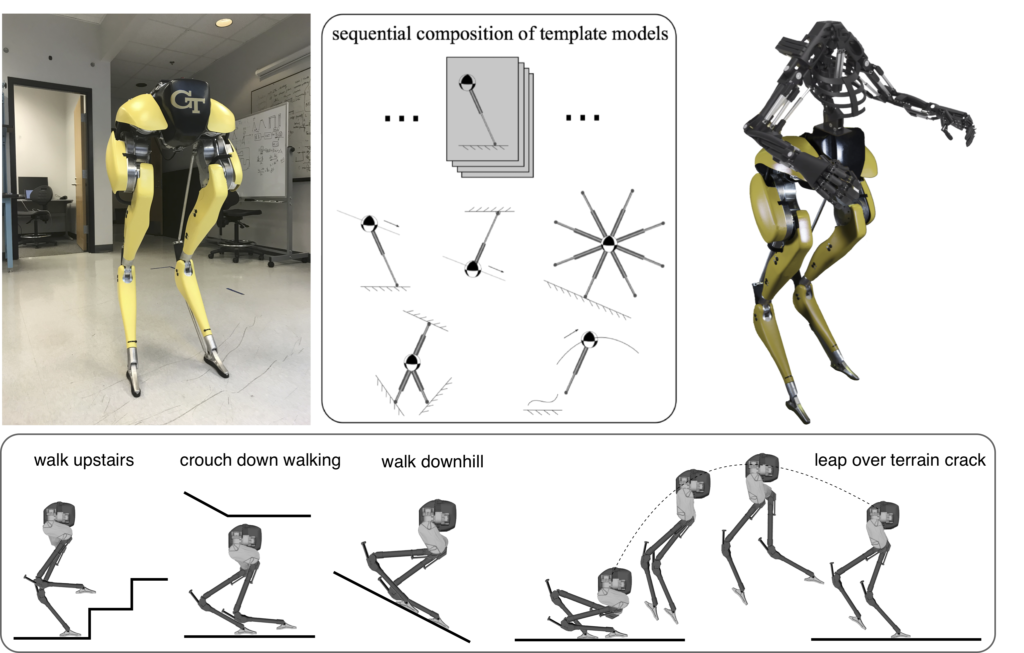
This research direction focuses on formal methods and decision-making algorithms of dynamic terrestrial locomotion and aerial manipulation in complex and human-surrounded environments. We aim at scalable planning and decision algorithms enabling heterogeneous robot teammates to dynamically interact with unstructured environments and collaborate with humans. In particular, we are interested in robust task and motion planning approaches that (i) abstract and unify diverse, complex low-level robot dynamics generally possessing under-actuated, hybrid, and nonlinear features; (ii) computationally efficient, safe and reactive decision-making algorithms explicitly taking into account dynamic environmental events and human motions. One of our long-term goals is to achieve a hierarchical and scalable planning framework with the following objectives: (i) robust, non-periodic motion planners and control barrier certificates for versatile terrestrial and aerial maneuvering; (ii) game-based reactive task planner in response to diverse and possibly adversarial environmental events; (iii) novel multi-agent decision-making approaches that decompose the entire robot team into multiple sub-teams with receding horizon approaches. We will adopt algorithmic methods at the interaction of formal methods, multi-agent systems, robust control, and machine learning. Formal guarantees such as robustness, safety, and runtime performance will be targeted. The proposed approach will be evaluated on our Buzzy Cassie robot and open-source simulations in Drake toolbox developed by TRI.
Research Challenge: For a highly heterogenous co-robot team, how to aim for a unified planning framework applicable to terrestrial and aerial robots involving distinct dynamics, including high-dimensional, nonlinear, hybrid, and underactuated features?How to achieve formal guarantee on individual robot safety, robot inter-connectivity specification accomplishment, andd global goal completion? When failure occurs during the low-level execution, what replanning strategy should be designed at the mission and task planning level or robust strategies can be targeted at the motion planning level?

This research project collaborates with Dr. Sam Coogan‘s group.
Representative publications:
Ye Zhao, Yinan Li, Luis Sentis, Ufuk Topcu, and Jun Liu. Reactive Task and Motion Planning for Robust Whole-Body Dynamic Locomotion in Constrained Environments. The International Journal of Robotics Research, Accepted, 2022. [pdf] [video]
Abdulaziz Shamsah*, Jonas Warnke*, Zhaoyuan Gu, and Ye Zhao. Integrated Task and Motion Planning for Safe Legged Navigation in Partially Observable Environments, (*equally contributed), 2021. [pdf] [video]
Zhaoyuan Gu, Nathan Boyd, and Ye Zhao. Reactive Locomotion Decision-Making and Robust Motion Planning for Real-Time Perturbation Recovery, 2021. [pdf] [video]
Ziyi Zhou, Dong Jae Lee, Yuki Yoshinaga, Dejun Guo, and Ye Zhao. Reactive Task Allocation and Planning of A Heterogeneous Multi-Robot System, 2021. [pdf] [video]
Michael E. Cao*, Jonas Warnke*, Ye Zhao, and Samuel Coogan. Leveraging Heterogeneous Capabilities in Multi-Agent Systems for Environmental Conflict Resolution. (*equally contributed), Submitted, 2021. [pdf]
Jonas Warnke*, Abdulaziz Shamsah*, Yingke Li*, and Ye Zhao. Towards Safe Locomotion Navigation in Partially Observable Environments with Uneven Terrain, (*equally contributed), IEEE Conference on Decision and Control (CDC), 2020. [pdf]
S. Kulgod*, J. Huang*, W. Chen*, Y. Zhao, and N. Atanasov. Temporal Logic Guided Locomotion Planning and Control in Cluttered Environments, (*first three authors are equally contributed), American Control Conference, 2020. [preprint]
Ye Zhao, Benito R Fernández, Luis Sentis. Robust optimal planning and control of non-periodic bipedal locomotion with a centroidal momentum model. The International Journal of Robotics Research, 36(11): 1211-1242, 2017. [bibTeX] [pdf] [code]
Ye Zhao, Benito R Fernández, Luis Sentis. Robust Phase-Space Planning for Agile Legged Locomotion over Various Terrain Topologies.. Robotics: Science and Systems, 2016. [bibTeX] [pdf] [slides]
